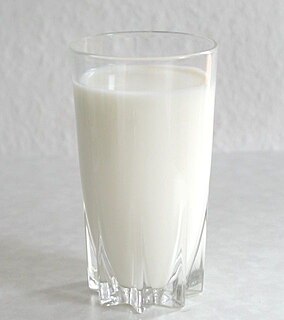
The chile relleno is a dish in Mexican cuisine that originated in the city of Puebla.

New Mexican cuisine is the cuisine of the Southwestern US state of New Mexico, the region is primarily known for its fusion of Pueblo Native American with Hispano Spanish and Mexican cuisine originating in Nuevo México. This cuisine had adaptions and influences throughout its history, including early on from the nearby Apache, Navajo, and throughout New Spain and the Spanish Empire, also from French, Italian, Mediterranean, Portuguese cuisine, and European cafés, furthermore during the American territorial phase from cowboy chuckwagons and Western saloons, additionally after statehood from Route 66 American diners, fast food restaurants, and global cuisine. Even so, New Mexican cuisine developed in fairly isolated circumstances, which has allowed it to maintain its indigenous, Spanish, and Mexican identity, and is therefore not like any other Latin food originating in the contiguous United States.
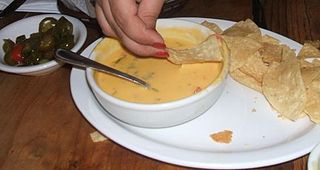
Chile con queso, sometimes described simply as queso, is an appetizer or side dish of melted cheese, or more usually, a pasteurised processed cheese food product such as Velveeta, and chili pepper typically served in Tex-Mex restaurants as a dip for tortilla chips.

Humita is a Native American dish from pre-Hispanic times, and a traditional food in Bolivia, Chile, although their origin is unclear. In Chile, they are known as humitas, in Bolivia as humintas, in Brazil as pamonha, and in Venezuela as hallaquitas. It consists of masa harina and corn, slowly steamed or boiled in a pot of water.

The Roman Catholic Diocese of Linares was established in Linares, Chile by Pope Pius XI on October 18, 1925 by means of the Bulla Notabiliter Aucto.
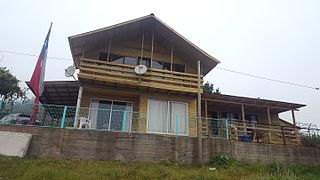
Pelluhue is a town and commune in the Cauquenes Province of central Chile's seventh region of Maule.

"Los Ruiles National Reserve" is a small nature reserve located in easternmost Municipality of Pelluhue, Province of Cauquenes, Maule Region, Chile.

Chanco is a Chilean commune located in Cauquenes Province, Maule Region.

Cauquenes Province is one of four provinces of the central Chilean region of Maule (VII). The provincial capital is the city of Cauquenes.
Panquehue is a semi-soft Chilean cheese produced in the Andean Aconcagua region. It is one of the most popular cheeses in Chile, it is similar in taste to Tilsit and often has chives or red pepper flakes mixed in. In 2005, it became the first Chilean cheese imported into the United States as part of the free trade agreement.

Barros Luco is a hot sandwich in Chile that includes beef and melted cheese in one of several types of bread. The sandwich is named after Chilean president Ramón Barros Luco, and was coined in the restaurant of the National Congress of Chile, where president Barros Luco always asked for this sandwich. Other sources point to Confitería Torres as the place where the sandwich was created.

Barros Jarpa is a popular sandwich in Chilean cuisine that includes ham and melted cheese. It is named after the 19th century Chilean Minister Ernesto Barros Jarpa, and was coined in the restaurant of the National Congress of Chile, where Barros Jarpa always asked for this sandwich. It's a derivative of the Barros Luco sandwich.

Chilean gastronomy stems mainly from the combination of traditional Spanish cuisine, Chilean Indigenous Mapuche culture and local ingredients, with later important influences from other European cuisines, particularly from Germany, Italy and France. The food tradition and recipes in Chile are notable for the variety of flavours and ingredients, with the country’s diverse geography and climate hosting a wide range of agricultural produce, fruits and vegetables. The long coastline and the peoples' relationship with the Pacific Ocean add an immense array of seafood products to Chilean cuisine, with the country's waters home to unique species of fish, molluscs, crustaceans and algae, thanks to the oxygen-rich water carried in by the Humboldt Current. Chile is also one of the world’s largest producers of wine and many Chilean recipes are enhanced and accompanied by local wines.

Concholepas concholepas, the Chilean abalone, is a species of large edible sea snail, a marine gastropod mollusk. Despite the superficial resemblance, C. concholepas is not a true abalone, but a member of the family Muricidae, also known as murex snails or rock snails. This species is native to the coasts of Chile and Peru, where it is called loco or pata de burro and chanque.

Queso flameado is a dish of hot melted cheese and spicy chorizo that is often served flambé. Often compared to cheese fondue, it is a party dish; it is popular at cookouts and in restaurants as an appetizer. Almost unique in Mexican cuisine, in the cuisine of the United States this dish has been widely adapted and is considered a native dish in El Paso. In Mexico, it occurs in restaurants more often in the north. Typical main ingredients are melted cheese and a characteristic meat sauce of loose fresh chorizo, tomato, onion, chile and spices. It is served in a small, shallow casserole or other ceramic or metal heat-proof baking dish. The cheese and sauce are prepared separately, and combined just before serving. This may be done at the table, especially if finished with a flambé: high alcohol liquor is poured on the cheese and ignited, and as it burns the server folds in the sauce. If not flambéed, the mixture may be quickly broiled. Either way, the finished dish is presented while it is still bubbling hot, and it is spooned onto small soft tortillas for individual servings.
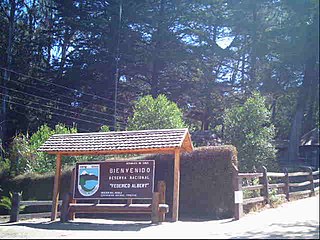
Federico Albert National Reserve is a 1.45 km2 (0.56 sq mi) national reserve of Cauquenes Province, Chile, located near Chanco town.
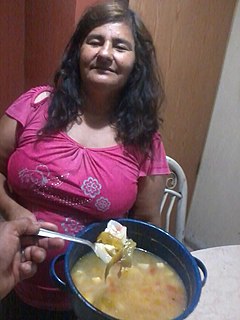
Caldo de queso is a traditional queso (cheese) soup made in places in Hermosillo, Sonora.
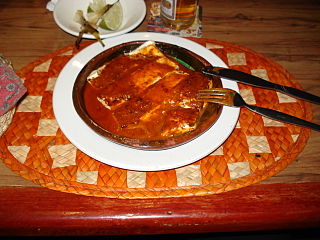
Queso en salsa or queso con chile is a typical dish in Mexican cuisine. It consists in cow's milk cheese submerged in a mild spicy salsa. There may be variations in the type of cheese used to make this dish, but the cheeses often selected are ranchero, Cotija, panela and Oaxaca. The salsa is made with red or green tomatoes, that are roasted with onion, garlic and chillies until golden, all blended and boiled in water, and may be seasoned with coriander leaves. The cheese is added after the boiling is off. For a sauce with red tomatoes, the preferred chiles are chipotle, pasilla or guajillo.

The Mongolian wolf is a subspecies of the grey wolf which is native to Mongolia, northern and central China, Korea, and the Ussuri region of Russia.


